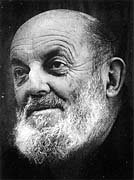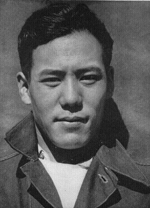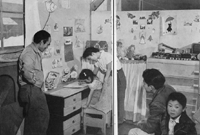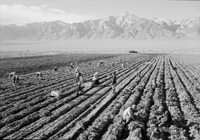Seeing Ansel Adams in a Different Light
By Mike McLeod
It is possible to think of Ansel Adams as only a great landscape
photographer, which is natural, considering he is one of America's most famous
photographers. Literally millions of people have seen his Moon Over Half Dome,
and hundreds of thousands own copies of it. But during his lifetime, Ansel Adams
also turned his lens in other directions and proved that he is an accomplished
documentary photographer. In 1944, he published the book, Born Free And Equal,
to both acclaim and outcry. It documented the life of Japanese-Americans and
Japanese aliens in the Manzanar War Relocation Center in California, and true to
form, Adams' work is striking.
Ansel Easton Adams was born on February 20,
1902 in San Francisco. His grandfather was a timber baron, and the family was
well off, but Ansel's father, Charles, lost the family fortune in the Panic of
1907. Charles spent the rest of his life trying to regain the family's financial
security, but he was unsuccessful.
Young Ansel grew up in the family home
near the beach, wandering among the dunes and glorying in the majesty of nature.
He did not fare well in school, but his creativity soon exhibited itself  but
not in the field of photography. At the age of 12, he taught himself to play the
piano and read music. He threw himself into this new love and practiced
intensely for years. In 1925, he decided to become a concert pianist. This all
changed in 1930 when he met Paul Strand, a famous photographer of the day. Under
his influence, Adams decided to change his career to photography.
Adams' love
of photography did not blossom overnight; it had been slowly growing for some
years. In 1916, his family took a trip to Yosemite National Park, and Adams
immediately fell in love with its wild beauty. It was here that he took his
first landscape photos with a Brownie box camera. Yosemite's appeal was so
strong that he returned there every year, and finally in 1979, he showcased this
spectacular park in the book, Yosemite and the Range of Light. It sold more than
two hundred thousand copies.
In 1917, Adams took a custodial job at the
headquarters of the Sierra Club in Yosemite. He often joined club members on
outings, and in 1927, he became its official photographer. Later, he joined the
board of directors. His talent for capturing dramatic images continued to grow,
and in 1928, he had his first exhibition. Two years later, he met Paul Strand,
and an American icon was born.
Manzanar
By the evening of the day Pearl Harbor was bombed, the FBI began
arresting suspected enemy agents and collaborators, including more than 2,000
Japanese. It was not until the following February that President Roosevelt
signed Executive Order 9066, which eventually resulted in the removal of between
110,000 and 120,000 people of Japanese descent from their homes.
One of
those taken was Harry Oye, an employee of Ansel Adams' father. The forced
evacuation infuriated Adams, not only because a family acquaintance was taken,
but also because most were American citizens. (In fact, two-thirds of the
Japanese relocated during the war were citizens.)
|

|
Mt. Wiliamson: This print, Mount Williamson, Sierra Nevada From Manzanar, 15
x 18.25 in., was sold by Sotheby's in Oct. 2006 for $40,800. It was printed no
later than 1948. Gelatin silver prints of the same photo have sold for : $19,200
(printed before 1960); $21,600 (printed in the 1960s); and $6,325 (printed in
1978).
|
Fortunately, fate
intervened in 1944 when Adams was invited to photograph the Manzanar War
Relocation Center. A friend from the Sierra Club was the camp administrator at
the time, and he extended the invitation, which was immediately accepted. The
result was an essay and just over 100 photos being published as Born Free and
Equal. The book made the San Francisco Chronicle's best seller list for two
months in 1945, but it also drew criticism from those suffering from the loss of
loved ones in the Pacific.
Certainly, the photos prove that Ansel Adams was
more than just a great landscape photographer and that he had a love for more
than just the land.
 In Born Free and Equal, Adams was remarkably even handed
in his grasp of the situation. He writes: In Born Free and Equal, Adams was remarkably even handed
in his grasp of the situation. He writes:
"Without doubt there were dangerous
individuals, groups and nationalistic
organizations among the Japanese prior
to Pearl Harbor. Many of these were known to the authorities and arrested and
properly interned. Espionage there was without doubt prior to Pearl Harbor, but
not one conviction of sabotage or espionage by Japanese-American citizens has
been obtained.
"The responsibility of the Military was tremendous; the
spectacular victories of Japan, the crippling of our fleet at Pearl Harbor, the
possibility of invasion of our west coast  all were facts of tragic import, and
at the time, were considered more than ample justification of the mass exodus.
In addition, there was the threat of public retaliation against the
Japanese-American population.the evacuation may have been unnecessary, but the
fact remains that we, as a nation, were in the most potentially precarious
moment of our history  stunned, seriously hurt, unorganized for actual war. Mr.
Merritt, Project Director at Manzanar, makes the following lucid statement on
the evacuation: 'Was evacuation justified? Evacuation is justified on the
grounds that, in time of war, military authorities are obligated to take any
steps authorized by the government and necessary to the internal security of the
country or for the defense of the country. The evacuation of 1942 has been, and
always will be, justified on the ground of military necessity. I have not said
that the evacuation was JUST, but that it was JUSTIFIED.'"1
Located
approximately 230 miles northeast of Los Angeles, the Manzanar War Relocation
Center had a breath-taking view of the Sierra Nevada Mountains. The camp itself
covered 620 acres, and it was created to be a self-sufficient community.
Inside
the fences were: a store or two, barbershops, beauty shops, a hospital, schools,
shoe repair shops, a newspaper, offices, meeting halls, libraries, gardens,
baseball and football fields, laundry facilities, churches, agricultural fields,
chicken houses, a pig farm and a nine-hole golf course. Barracks with tarpaper
walls were subdivided into apartments for families, but lavatories were
communal, as were the mess halls. Waiting in line was a way of life that
happened several times every day.
At its peak, Manzanar housed about 10,000
people. When Adams visited, he reported that about 5,500 lived there.
Despite all the facilities listed above, life was not a bowl of cherries in
this arid land. The climate ranged from snow in the winter to summer heat
reaching 100 degrees at times. Wind and dust were constant aggravations.
For
all their power and beauty, Ansel Adams' photos of Manzanar don't necessarily
tell the full story of a people taken from their homes, their businesses, and
their lives and forcibly evacuated because of their ethnicity. (Fortunately, the
essay does tell the story.) If anything, his photos show a clean and cultured
people who were coping well despite the circumstances. This could be any small
town in America, except for the guard towers and barbwire fences, which aren't
pictured in the photos. When looking at them, one must remember that this is
prison.
However, Manzanar was not a concentration camp or a gulag. There were
no human skeletons there, as was seen in the German and Japanese prisoner-of-war
camps. There were no human medical experiments, and families were usually
allowed the privilege of staying together. Yet, people were shot and killed in
Manzanar and other camps (overall, an estimated less than two-tenths of one
percent) Â some while trying to escape, some during riots, and some from simple
hate because of the war. America took a terrible beating much of the time in
World War II, so many of the army and security personnel guarding the camps took
out their frustrations on the Japanese-Americans.
What is not shown in the
photos are the convoluted feelings behind the smiling faces, of their being
loyal citizens yet having their rights trampled. What Ansel Adams has captured
is what the Japanese-Americans wanted us to know  that they were loyal and
obedient citizens who were willing to support its government, right or wrong.
Most of the relocation camps were closed in 1944, but one operated until
1946. In 1988, Congress issued an apology for the interment and paid $20,000 to
Japanese-Americans who suffered because of it.
In 1968, Ansel Adams received
the Conservation Service Award from the Interior Department, its highest
civilian honor, and in 1980, he was awarded the Presidential Medal of Freedom.
Both were awarded for his environmental and conservation efforts. Yes, Ansel
Adams was more than a landscape photographer. He also cared greatly about the
rights of others. He concluded Born Free and Equal with: "We must be certain
that, as the rights of the individual are the most sacred elements of our
society, we will not allow passion, vengeance, hatred, and racial antagonism to
cloud the principle of universal justice and mercy."2
Ansel Easton Adams
passed away on April 22, 1984 of heart failure and cancer.
1
Adams, Ansel, Born Free and Equal, The Story of Loyal Japanese Americans (New
York: U.S. Camera, 1944), pp. 34 and 36.
2 Ibid, p. 110.
All photos,
unless otherwise noted, courtesy Library of Congress.
Note: other
nontraditional Ansel Adams photos can be seen at: http://www.lapl.org, then
search "Ansel Adams" in "Photo Library."

|

Ansel Adams.

Evacuees leaving a Buddhist
church. Catholic and other
Christian churches
also held
services in the camp.

Richard Kobayashi, farmer.

Itidemi Tayenaka.

A co-op store displaying
pies for sale.

Yonehisa Yamagami,
electrician.

The Tojo Miatake family in their
barracks' apartment.

Mr. & Mrs. Dennis Shimizu at the door to their
barracks'
apartment.

A dressmaking class.

The Yanemitsu family in their barracks' apartment.

Farm workers harvested much of their own food; Mt. Williamson is in the
background. |